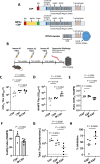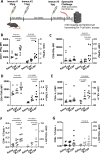iDC-targeting PfCSP mRNA vaccine confers superior protection against Plasmodium compared to conventional mRNA
- PMID: 39971939
- PMCID: PMC11840135
- DOI: 10.1038/s41541-025-01089-x
iDC-targeting PfCSP mRNA vaccine confers superior protection against Plasmodium compared to conventional mRNA
Abstract
Malaria resurgence in 2022 saw 249 million clinical cases and 608,000 deaths, mostly in children under five. The WHO-approved circumsporozoite protein (CSP)-targeting vaccines, RTS,S and R21, remain limited in availability. Strong humoral responses are crucial for sporozoite neutralization before hepatocyte infection, yet first-generation vaccines provide suboptimal protection, necessitating improved strategies. With the success of mRNA-LNP vaccines against COVID-19, there is interest in leveraging this approach to malaria. Here, we developed a novel chemokine fusion mRNA vaccine targeting immature dendritic cells (iDC) to enhance immunity against P. falciparum CSP (PfCSP). Mice immunized with MIP3α-CSP mRNA-LNP exhibited stronger CD4 + T cell responses and higher anti-NANP6 antibody titers than conventional CSP mRNA-LNP. Importantly, upon P. berghei PfCSP transgenic sporozoite challenge, MIP3α-CSP mRNA provided significantly greater protection from liver infection, strongly associated with multifunctional CD4 + T cells and anti-NANP6 titers. This study underscores iDC targeting as a promising strategy to enhance malaria vaccine efficacy.
© 2025. The Author(s).
Conflict of interest statement
Competing interests: D.W. is named on patents describing the use of nucleoside-modified mRNA - lipid nanoparticle vaccines. Y.T. is an employee of Acuitas Therapeutics that is involved in the development of mRNA-LNP therapeutics. D.W. and M.-G.A. are listed as inventors on patents covering LNP for nucleic acid therapeutic delivery for vaccines. Y.S., V.V., J.T.G., J.M., Y.L., E.G., Y. F-G., N.C., D.S., R.M, and P.S. have no competing interests.
Figures




Update of
-
Immature dendritic cell-targeting mRNA vaccine expressing PfCSP enhances protective immune responses against Plasmodium liver infection.Res Sq [Preprint]. 2024 Jul 9:rs.3.rs-4656309. doi: 10.21203/rs.3.rs-4656309/v1. Res Sq. 2024. Update in: NPJ Vaccines. 2025 Feb 19;10(1):34. doi: 10.1038/s41541-025-01089-x. PMID: 39041038 Free PMC article. Updated. Preprint.
References
-
- Organization WH. World Malaria Report 2022. https://www.who.int/teams/global-malaria-programme/reports/world-malaria....
-
- Schuerman, L. RTS,S malaria vaccine could provide major public health benefits. Lancet394, 735–736 (2019). - PubMed
-
- Datoo, M. S. et al. Safety and efficacy of malaria vaccine candidate R21/Matrix-M in African children: a multicentre, double-blind, randomised, phase 3 trial. Lancet403, 533–544 (2024). - PubMed
-
- Datoo, M. S. et al. Efficacy and immunogenicity of R21/Matrix-M vaccine against clinical malaria after 2 years’ follow-up in children in Burkina Faso: a phase 1/2b randomised controlled trial. Lancet Infect. Dis.22, 1728–1736 (2022). - PubMed
Grants and funding
LinkOut - more resources
Full Text Sources
Research Materials

